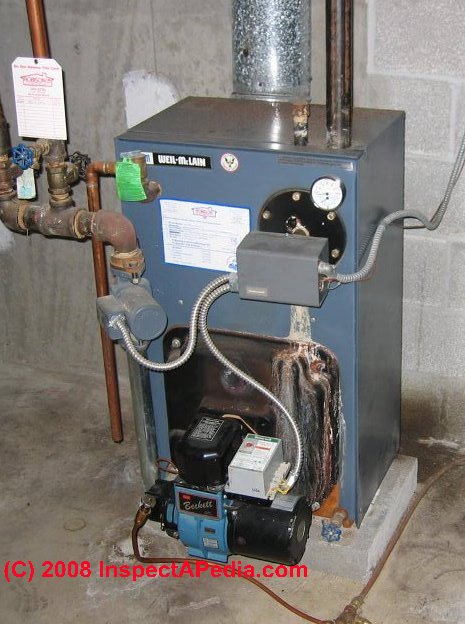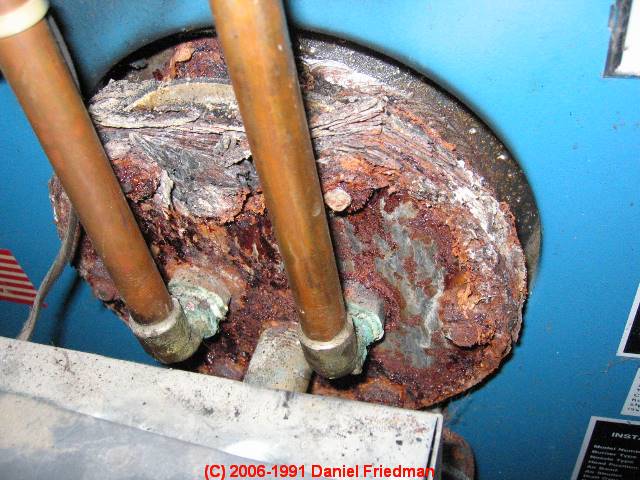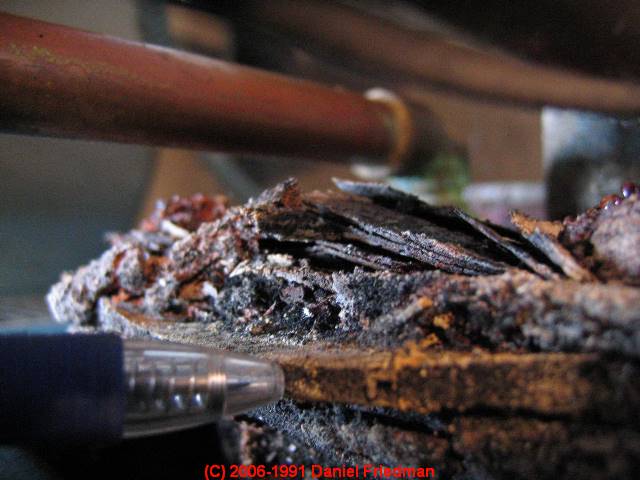 Leaks at tankless coils: location, cause, detection, fix
Leaks at tankless coils: location, cause, detection, fix
How to Diagnose, Evaluate & Repair Leaks at a Tankless Coil on a Heating Boiler or in an Indirect Water Heater
- POST a QUESTION or COMMENT about the types of leaks that occur on tankless coils, where they are found, what problems the leaks cause, and a leaky tankless coil can be repaired, or if necessary, replaced.
Tankless hot water coil leaks, corrosion, & repair procedures:
In this article series we explain how to spot, evaluate, and repair leaks at the tankless coil used on heating boilers to provide domestic hot water or leaks in the hot water heating coil used on indirect-fired water heaters.
Leaks can occur at a tankless coil where it is mounted to the top or side of a heating boiler or water tank (if an indirect water heater is in use), at fittings connecting hot and cold water piping to the coil, and more subtle leaks can occur inside the boiler or water tank - leading to excessive boiler pressure and to dangerous TPR relief valve leaks.
InspectAPedia tolerates no conflicts of interest. We have no relationship with advertisers, products, or services discussed at this website.
- Daniel Friedman, Publisher/Editor/Author - See WHO ARE WE?
How to Find, Diagnose & Fix Leaks at Tankless Coils & Indirect Water Heater Coils
 Leaks at tankless coils on heating boilers can seep away for a long time before anyone notices. But if you wait too long, the boiler may be beyond repair.
Leaks at tankless coils on heating boilers can seep away for a long time before anyone notices. But if you wait too long, the boiler may be beyond repair.
This article provides a guide to recognizing and evaluating leaky boilers:
- How to evaluate the severity of leaks at a hot water tankless coil.
- Why leaks at a tankless coil can ruin a heating boiler.
- How to inspect repair leaks at tankless coils on heating boilers.
We address these tankless coil leak questions: When is a tankless coil leak or indirect water heater coil leak repairable? Leaks at the tankless coil mounting plate can often be repaired if caught early.
Severe rust at a tankless coil mounting plate means tankless coil replacement is impossible and the boiler may be ruined. When is boiler replacement necessary? How to diagnose a tankless coil that leaks into the heating boiler.
Common locations of external leaks at or around tankless coils on the heating boiler that leak out of the coil or boiler or indirect water heater
Boiler leaks out at a tankless coil mounting plate or at the pipe fittings that pass through the coil mounting plate are a common defect on heating boilers, both steel and cast iron units. You may not see water (the boiler is hot, after all) but you'll see mineral deposits and crud or even crud and rust build-up at the leak source and below it.
Watch out: aught and repaired early these leaks at a tankless coil can be repaired without serious damage to the heating boiler. Left alone these same leaks, particularly at the tankless coil mounting plate can completely destroy the heating boiler.
Deciding how badly a heating boiler has been damaged by leaks is tricky, controversial, and important since both safety and big cost concerns are involved.
- At the tankless coil face tapping for mounting a temperature sensor (bottom center pipe shown in this photo, leading to a boiler combination control).
- At the tankless coil face tapping for the incoming cold water or outgoing hot water pipe (the two copper pipes shown in this photo)
- At the tankless coil mounting plate where it is bolted to the face of the heating boiler (the round and rusty steel face shown in this photo) or at the heat exchanger coil mounting plate on the side or bottom of an indirect fired water heater
Leaks at the heating boiler - coil: A leak at any of these points will not normally show up as water on the boiler or on the indirect water heater or on the floor around the boiler or around the indirect fired water heater. That's because the boiler is normally hot all of the time. Water leaking at any of these locations on a heating boiler will rapidly evaporate.
Leaks at the indirect fired water heater: Water leaking out of the coil mounting plate or fittings on an indirect fired water heater may appear as a puddle on the floor or it may be absorbed in water heater insulation where it is evaporated - for a time, until the leak gets bad-enough to show up externally.
How to Evaluate an External Leak at a Tankless Coil on a Heating Boiler
Young leaks at a tankless coil can be repaired
 If a leak is found in time, that is, before severe rusting and exfoliating or flaking rust have occurred, it should be possible to disassemble, clean, seal, and re-assemble the parts.
If a leak is found in time, that is, before severe rusting and exfoliating or flaking rust have occurred, it should be possible to disassemble, clean, seal, and re-assemble the parts.
In our photo at left we'd probably call this a "middle-aged" leak rather than a "young leak" because the white mineral salt deposit you see below the tankless coil on the face of the boiler is pretty thick.
But it's possible that this tankless coil leak can be repaired
A closer inspection is needed.
- Leaks at piping connections on the tankless coil itself can be repaired without removing the whole coil assembly from the boiler.
- Leaks at the tankless coil mounting plate will require that the boiler be shut down, drained, and water piping connections cut or opened at the coil so that the coil assembly can be removed.
If inspection shows that the coil face and boiler mating face are un-damaged, the mounting gasket is replaced, sealed, and the coil reassembled to the boiler.
This may seem an odious task, since it means you'll need to shut down the boiler and also domestic hot water, and boiler water and piping water may need to be drained or partly drained in order to make this repair.
But you should make this repair as soon as possible.
Old leaks at a tankless coil may require boiler replacement
If a leak is not found in time, or if no one was willing to repair a young leak, the cost is likely to be very high.
Leaks at piping connections through the face plate of the tankless coil, if they have progressed for a long time, will have caused so much corrosion that disassembly and repair of the coil is impossible.
The good news is that leaks at this location only destroy the tankless coil itself and are less likely to destroy the whole heating boiler. The coil will need to be removed and replaced.
The white deposits on the face of this tankless coil appear to originate at a pipe connection at the coil face (top center of the photo); but notice that second leak trace to the right of the white one?
This tankless coil may also be leaking at its gasket. Our next photos show how prolonged leaks at the coil face plate mounting gasket can destroy a heating boiler.
What evidence of leaks will we observe at a boiler with leaks at the tankless coil?
White or other mineral salts left behind from evaporating leaky water, at and below the point of leakage, often staining the face of the boiler, such as we show in the photograph above.
Even without close inspection one can observe white leak stains below the round black tankless coil plate and running down the face of the boiler in this installation.
Rust or corrosion at the point of leak, such as the flaking exfoliating and badly rusted tankless coil we show in our photograph at left. .
A leak that has produced rust like this might mean that the tankless coil unit needs to be replaced, or worse, that the boiler has been so damaged by rust that it is beyond repair.
Our next photos show how prolonged leaks at the coil face plate mounting gasket can destroy a heating boiler.
Photo Guide to Severe Tankless Coil Leak & Rust Damage
Leaks at piping connections through the face plate of the tankless coil, if they have progressed for a long time, will have caused so much corrosion that disassembly and repair of the coil is impossible.
The good news is that leaks at this location only destroy the tankless coil itself and are less likely to destroy the whole heating boiler. The coil will need to be removed and replaced.
Severe Leaks at the tankless coil mounting plate, if they have progressed for a long time, will have caused damage to the coil mounting plate.
But much worse, the mounting surface on the boiler will also be damaged. If the boiler surface has been damaged it may be impossible to mount a replacement tankless coil without continuing leakage.
It is technically possible to perform a repair to such a boiler by welding on a new coil mounting surface, but the welder is not going to be very interested in performing such a small but time consuming repair, and knowing that the alternative to her welding service is a whole boiler replacement, the price for the welding job may be rather high.
Other Tankless Coil Problems & Repairs
Leaks from a tankless coil into the heating boiler
See TANKLESS COIL INTERNAL LEAKS INTO the BOILER
Internal Leaks in an Indirect Water Heater's Coil
see INDIRECT WATER HEATER COIL LEAKS INTO the BOILER
Directions of Water Leakage: Tankless Coil or Indirect Water Heater Coil Leaks
see TANKLESS COIL LEAK DIRECTION IN or OUT<
Diagnose a tankless coil that is leaking into the heating boiler >
see EVIDENCE of TANKLESS INTERNAL COIL LEAK INTO BOILER / WATER TANK
Which Tankless Coil Leaks & Boiler Leaks Can Be Repaired and When is the Boiler Ruined?
see REPAIR OPTIONS for TANKLESS COIL LEAKS for a discussion of leaks in both tankless coils on heating boilers and the heating coil used on indirect-fired water heaters.
...
...
Continue reading at TANKLESS COIL INTERNAL LEAKS INTO the BOILER or select a topic from the closely-related articles below, or see the complete ARTICLE INDEX.
Or see TANKLESS COIL / HOT WATER COIL LEAK FAQs - questions & answers about leaky tankless coils for domestic hot water, posted originally at this page.
Or see these
Tankless hot water coil Articles
- BOILER LEAKS CORROSION STAINS for a discussion of other leaks on heating boilers.
- RELIEF VALVE LEAKS
- TANKLESS COILS
- AQUASTAT CONTROL FUNCTIONS
- CLOGGED PIPES / TANKLESS COIL DE-SCALE
- MIXING / ANTI-SCALD VALVES
- TANKLESS COIL ANTI-SCALD-VALVE
- TANKLESS COIL CLOG DE-SCALE
- TANKLESS COIL ABANDONMENT or CONVERSION
- TANKLESS COIL HOT WATER HEATER TEMPERATURE CONTROL
- TANKLESS COIL HOT WATER INCREASE
- TANKLESS COIL INSTALLATION PROCEDURE
- TANKLESS COIL INTERNAL LEAKS INTO the BOILER
- TANKLESS COIL / HOT WATER COIL LEAKS
- WATER HEATER LEAK REPAIR
Suggested citation for this web page
TANKLESS COIL / HOT WATER COIL LEAKS at InspectApedia.com - online encyclopedia of building & environmental inspection, testing, diagnosis, repair, & problem prevention advice.
Or see this
INDEX to RELATED ARTICLES: ARTICLE INDEX to WATER HEATERS
Or use the SEARCH BOX found below to Ask a Question or Search InspectApedia
Ask a Question or Search InspectApedia
Try the search box just below, or if you prefer, post a question or comment in the Comments box below and we will respond promptly.
Search the InspectApedia website
Note: appearance of your Comment below may be delayed: if your comment contains an image, photograph, web link, or text that looks to the software as if it might be a web link, your posting will appear after it has been approved by a moderator. Apologies for the delay.
Only one image can be added per comment but you can post as many comments, and therefore images, as you like.
You will not receive a notification when a response to your question has been posted.
Please bookmark this page to make it easy for you to check back for our response.
IF above you see "Comment Form is loading comments..." then COMMENT BOX - countable.ca / bawkbox.com IS NOT WORKING.
In any case you are welcome to send an email directly to us at InspectApedia.com at editor@inspectApedia.com
We'll reply to you directly. Please help us help you by noting, in your email, the URL of the InspectApedia page where you wanted to comment.
Citations & References
In addition to any citations in the article above, a full list is available on request.
- Mark Cramer Inspection Services Mark Cramer, Tampa Florida, Mr. Cramer is a past president of ASHI, the American Society of Home Inspectors and is a Florida home inspector and home inspection educator. Mr. Cramer serves on the ASHI Home Inspection Standards. Contact Mark Cramer at: 727-595-4211 mark@BestTampaInspector.com
- John Cranor [Website: /www.house-whisperer.com ] is an ASHI member and a home inspector (The House Whisperer) is located in Glen Allen, VA 23060. He is also a contributor to InspectApedia.com in several technical areas such as plumbing and appliances (dryer vents). Contact Mr. Cranor at 804-873-8534 or by Email: johncranor@verizon.net
- In addition to citations & references found in this article, see the research citations given at the end of the related articles found at our suggested
CONTINUE READING or RECOMMENDED ARTICLES.
- Carson, Dunlop & Associates Ltd., 120 Carlton Street Suite 407, Toronto ON M5A 4K2. Tel: (416) 964-9415 1-800-268-7070 Email: info@carsondunlop.com. Alan Carson is a past president of ASHI, the American Society of Home Inspectors.
Thanks to Alan Carson and Bob Dunlop, for permission for InspectAPedia to use text excerpts from The HOME REFERENCE BOOK - the Encyclopedia of Homes and to use illustrations from The ILLUSTRATED HOME .
Carson Dunlop Associates provides extensive home inspection education and report writing material. In gratitude we provide links to tsome Carson Dunlop Associates products and services.



